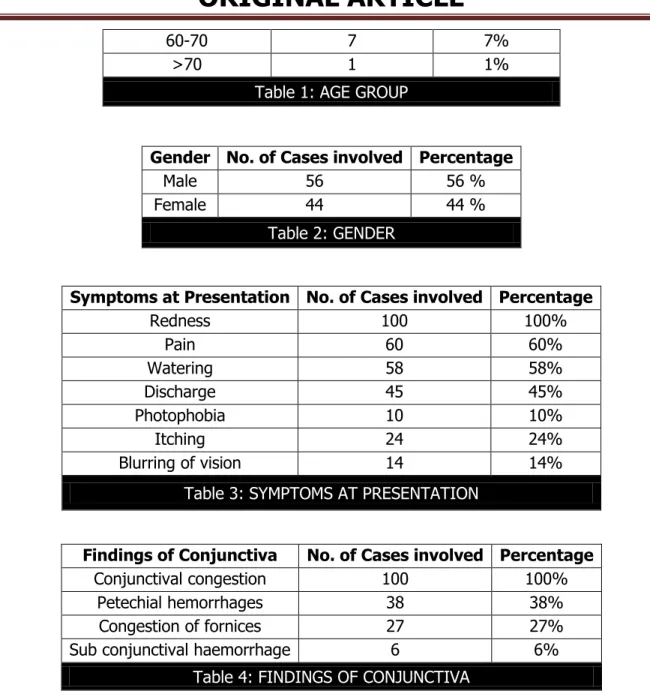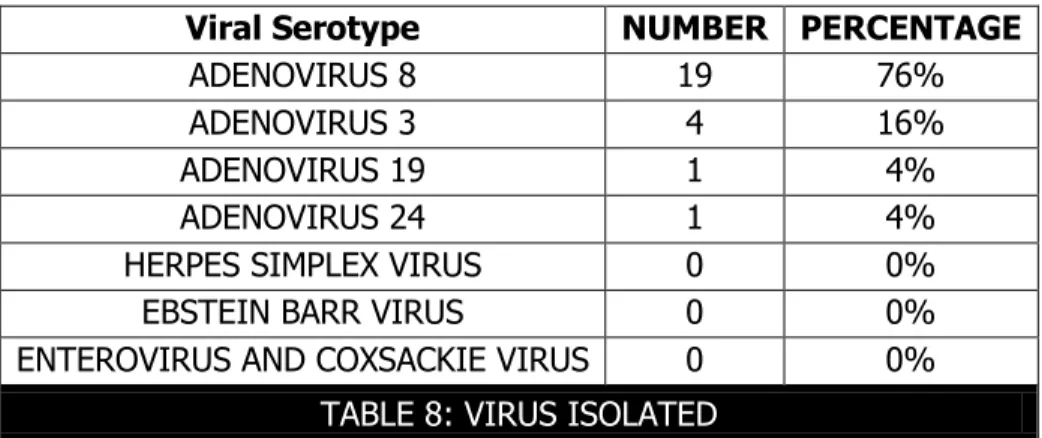ORIGINAL ARTICLE
J of Evidence Based Med & Hlthcare, pISSN- 2349-2562, eISSN- 2349-2570/ Vol. 2/Issue 15/Apr 13, 2015 Page 2296
PROFILE OF VIRAL CONJUCTIVITIS
M. Gopal Kishan1, Sheetal Baldava2, Jitha Vinay Reddy3HOW TO CITE THIS ARTICLE:
M. Gopal Kishan, Sheetal Baldava, Jitha Vinay Reddy. ”Profile of Viral Conjuctivitis”. Journal of Evidence based Medicine and Healthcare; Volume 2, Issue 15, April 13, 2015; Page: 2296-2302.
ABSTRACT: INTRODUCTION: Viral conjunctivitis is most commonly seen in the outpatient department. A variety of viruses which are responsible for conjunctival infection, of which Adenovirus is the most common. It is highly contagious during the first 2 weeks of infection. It can cause corneal involvement within 4-5 days after the onset of symptoms. Corneal lesions range from SPK (Superficial Punctate Keratitis) to epithelial defects. These corneal lesions may cause intense photophobia and impairment of vision. AIM: To find out the commonest etiological agent, to study the clinical features and complications related to it. METHODOLOGY: This study was carried out prospectively. 100 patients who came to outpatient department between October 2013 to October 2014 were enrolled in the study. All the age groups and both the genders were included. Patients underwent slit lamp examination and were diagnosed clinically. 25 cases were submitted for Gram staining and Polymerase Chain Reaction (PCR) study to know the type of virus and serotype. RESULT: 100 patients were diagnosed with viral conjunctivitis and were kept on follow up. 21percent of patients developed SPK. Adenovirus 8 was found to be more common than other viruses. CONCLUSION: The present study showed Adeno virus to be the most common etiological agent causing viral conjunctivitis and complications like subepithelial opacities and diminished vision.
KEYWORDS: Sub Conjunctival Haemorrhage (SCH), Superficial Punctate Keratitis (SPK), Sub Epithelial Opacities, Petechial Hemorrhages, Polymerase Chain Reaction (PCR).
INTRODUCTION: According to WHO corneal diseases constitute the 2nd most common cause of blindness in the world at present.
A variety of viruses cause conjunctivitis. Of them Adenovirus is the most common and is highly contagious during the first 2 weeks of infection.1
Epidemic keratoconjuctivitis is caused by adenoviruses.2
These viruses are transmitted through droplets and smears of infected body fluids that enter the human body through nose, throat and conjunctiva.
The period of viral incubation is 2 to 12 days.
The disease is probably contagious even before symptoms arise and it certainly remains so, as long as the virus can still be demonstrated in body fluids. This period usually lasts for two to three weeks from the date of transmission of the virus. Ocular adenoviral infection can cause corneal involvement within 4-5 days after the onset of symptoms.
Corneal lesions range from diffuse fine superficial punctate keratitis to epithelial defects and finally to sub epithelial nummular opacities which can last long, even for years.
ORIGINAL ARTICLE
J of Evidence Based Med & Hlthcare, pISSN- 2349-2562, eISSN- 2349-2570/ Vol. 2/Issue 15/Apr 13, 2015 Page 2297
antigen. These infilitrates coalesce to form deeper sub epithelial lesions to produce nummular keratitis.
AIMS AND OBJECTIVES:
To study the clinical aspects of viral conjunctivitis.
To study the complications related to viral conjunctivitis.
To find out the commonest etiological agent of viral conjunctivitis in study population.
MATERIAL AND METHODS: The present study is a prospective study. 100 patients with viral conjunctivitis who attended to OPD in Princess Esra Hospital between October 2013 to October 2014 were enrolled in the study.
Patients of all age groups and both genders were included in the study. Follow up was done for 3 months. We have excluded all cases with allergic conjunctivitis and other chronic conjuctivitis and patient not willing for followup. After obtaining informed consent of every patient, a detailed examination was done including history, clinical features, visual acuity, slit lamp examination and systemic examination.
In 25 cases, two conjuctival swabs were taken, one from inferior tarsal conjunctiva and the other from lower fornix under topical anaesthesia under strict asepsis to avoid contamination of specimen.
One swab from each case was sent for Gram’s stain to rule out bacterial conjunctivitis and the other swab was stored in viral transport medium and sent for study of Polymerase Chain Reaction (PCR)3 to confirm the diagnosis of viral conjunctivitis and the type of virus.
Meanwhile, patients were treated with topical antibiotic4.
After 1 week, patients were reviewed to detect corneal involvement. Patients were assessed on the basis of questionnaire which included the level of improvement of symptoms, symptoms that suggested corneal involvement, similar complaints in other members of the family. Slit lamp examination was done to look for corneal lesions. Patients were followed up once in a week until conjunctivitis resolved.
Corneal lesions were assessed in each follow up with current treatment for 3 months.
OBSERVATION AND RESULTS:
In our study, most of the patients were males (56%). Most common age group was between 20-40 years (46%) Most common eye involved was right eye (56%)
AGE GROUP (YRS) CASES INVOLVED PERCENTAGE
0-20 21 21%
20-30 24 24%
30-40 22 22%
40-50 21 21%
ORIGINAL ARTICLE
J of Evidence Based Med & Hlthcare, pISSN- 2349-2562, eISSN- 2349-2570/ Vol. 2/Issue 15/Apr 13, 2015 Page 2298
60-70 7 7%
>70 1 1%
Table 1: AGE GROUP
Gender No. of Cases involved Percentage
Male 56 56 %
Female 44 44 %
Table 2: GENDER
Symptoms at Presentation No. of Cases involved Percentage
Redness 100 100%
Pain 60 60%
Watering 58 58%
Discharge 45 45%
Photophobia 10 10%
Itching 24 24%
Blurring of vision 14 14%
Table 3: SYMPTOMS AT PRESENTATION
Findings of Conjunctiva No. of Cases involved Percentage
Conjunctival congestion 100 100%
Petechial hemorrhages 38 38%
Congestion of fornices 27 27%
Sub conjunctival haemorrhage 6 6%
Table 4: FINDINGS OF CONJUNCTIVA
On slit lamp examination, the most common conjunctival finding was congestion in 100%, petechiae in (38%), congestion of fornices in 27% and su conjunctival haemorrhage in 6% of cases.
Slit lamp examination with
corneal involvement No. of Cases involved Percentage
Superficial punctuate keratitis 21 21%
Subepithelial opacities 15 15%
Table 5: SLIT LAMP EXAMINATION WITH CORNEAL INVOLVEMENT
ORIGINAL ARTICLE
J of Evidence Based Med & Hlthcare, pISSN- 2349-2562, eISSN- 2349-2570/ Vol. 2/Issue 15/Apr 13, 2015 Page 2299
GRAM STAIN NO. OF CASES PERCENTAGE
NEGATIVE 21 84
PUS CELLS 3 12
GRAM POSITIVE COCCI 1 4
Table 7: CONJUCTIVAL SWAB RESULT: (25 CASES)
Gram positive cocci were identified in 1 case.
Viral Serotype NUMBER PERCENTAGE
ADENOVIRUS 8 19 76%
ADENOVIRUS 3 4 16%
ADENOVIRUS 19 1 4%
ADENOVIRUS 24 1 4%
HERPES SIMPLEX VIRUS 0 0%
EBSTEIN BARR VIRUS 0 0%
ENTEROVIRUS AND COXSACKIE VIRUS 0 0%
TABLE 8: VIRUS ISOLATED
ADENOVIRUS 8 was the most common isolated serotype.
Conjunctival Congestion In lower fornices
Viral Conjunctivitis with Petcehial Haemorrages in upper palpebral conjunctiva
Congestion seen in upper Palperabral Conjunctiva
ORIGINAL ARTICLE
J of Evidence Based Med & Hlthcare, pISSN- 2349-2562, eISSN- 2349-2570/ Vol. 2/Issue 15/Apr 13, 2015 Page 2300
DISCUSSION: In our study 100 patient were enrolled. Most of the patients completed the require period of 3 months follow up.
In our study 46% of the patients were in the age group of 20-40 years. Similar results were obtained in the studies done by Dr. Sheeja Vishwanath et al5 and Aoki Koki et al.6 In the study done by Dr. Sheeja Vishwanath et al5 the age incidence was 40% in the age group of 20 to 40 years followed by 40 to 60 years (27%). In the study by Aoki Koki et al,6 it was 48% in the age group of 20 to 39 years.
In our study 56% were males and 44% were females. Similar results were obtained in the study by Dr. SheejaVishwanath et al.5 Out of 55 patients they studied, 52.72% (29) were males and 47.28% (26) were females. The slightly higher prevalence in males was due to the fact that males are more involved in outdoor activities. Right eye was effected 56% and left eye was affected in 44% of our cases.
In our study, the symptoms noted were; Redness in 100%, Pain in 60%, Watering in 58%, Mucoid discharge in 45% and Itching in 24% of the cases. In the study by Uchio E et al7 the symptoms noted were; Redness in 100%, Mucoid discharge in 82.6%, itching 52.2% and watering in 30.4% of cases.
All patients had conjunctival congestion, 38% of the patients had fine petechial haemorrhages in upper and lower tarsal conjunctiva, 27% of patients had Petechiae with papillary reaction of conjunctiva, 21% of patients had superifical puctate keratitis. In the study done by Dr. Sheeja Vishwanath et al5, they reported conjunctival congestion and conjunctival papillae in all patients (100%), sub conjunctival haemorrhage in 10.90%, petechial hemorrhages in 63.63%, superficial punctuate keratitis in 24% and sub conjunctival haemorrhage in 6% of cases.
In our study 15% of patients had sub epithelial opacities at the end of 3 months follow up. Similar results have been obtained by Dr. Sheeja Vishwanath et al5 who reported keratitis in 10.8% of cases.
ORIGINAL ARTICLE
J of Evidence Based Med & Hlthcare, pISSN- 2349-2562, eISSN- 2349-2570/ Vol. 2/Issue 15/Apr 13, 2015 Page 2301
Most common virus found under Polymerase chain reaction was Adenovirus 8 (76%). Similar result have been obtained by Aoki koki et al adenovirus 8 (60.6%).
CONCLUSION:
Majority of the patient were in the age group of 20-40 years (46%).
Males were more affected (56%)
The presentation was unilateral in (90%) and bilateral in (10%) of cases.
37% had history of contact from other members of the family.
Redness was present in all the patients, pain was present in (60%), Watering in (58%), Mucoid discharge in (45%).
All patient had conjunctival congestion predominantly in the fornices. The predominant feature noted in the conjunctiva was fine petechiae in the upper and lower tarsal conjunctiva which was seen in 38%, sub conjunctival haemorrhage was in 6% of cases.
21% of patients had superficial puctate keratitis.
15% of the patients had subepithelial opacities on follow up visits.
Adenovirus 8 was the most common serotype involved.
Superifical punctate keratitis in adeonovirus conjunctivitis progressed to sub epithelial opacity at the end of 1 month.
Viral conjuctivitis is a common ocular condition to the outpatient department. The present study showed that Adenovirus 8 was the most common etiological agent causing viral conjunctivitis and the most common serotype causing subepithelial opacities which affected vision.
REFERENCES:
1. O’Day DM, et al: Clinical and laboratory evaluation of epidemic Keratoconjuvtivits due to adenovirus types 8 and 19. Am j Ophthalmol 1976; 81: 207.
2. Pavan-langston D, Dunkel E: Major Ocular infections: herpes simplex, adenovirus, epsteins-barr virus, pox. In: Galasso G, Merigan T, Whitley R, ed. Antiviral agents and viral dieases of man, Philadelphia: Lippincott-Raven; 1997: 187-228.
3. Robert J. Copper, Adrian C. Yeo, X Andrew S. Bailey, and Andrew B. Tullo. Adenovirus polymerase chain reaction assay for rapid diagnosis of conjunctivitis. Invest Ophthamolvis sci.1999: 40: 990-95.
4. Conjunctivitis: A systematic review of diagnosis and treatment JAMA 2013 October 23; 310(16): 1721-1729.
5. Dr. Sheejavishwanath Ms et al. Clinical and Virological study of Conjunctivitis during the epidemic in calicutt October- December 2006 June 2008 KJO vol. XX, no.2.
6. Koki Aoki, Michiokato, Hideoohtsuka. Keizoishii, Naokinakazono clinical and aetiological study of adenoviral conjunctivitis bjo, 1982, 66.776-780.
ORIGINAL ARTICLE
J of Evidence Based Med & Hlthcare, pISSN- 2349-2562, eISSN- 2349-2570/ Vol. 2/Issue 15/Apr 13, 2015 Page 2302
NAME ADDRESS EMAIL ID OF THE CORRESPONDING AUTHOR:
Dr. M. Gopal Kishan, Professor and Head,
Department of Ophthalmology, Deccan College of Medical Sciences, Hyderabad.
E-mail: gopalkishan.mutyala@gmail.com
Date of Submission: 28/03/2015. Date of Peer Review: 30/03/2015. Date of Acceptance: 07/04/2015. Date of Publishing: 09/04/2015.
AUTHORS:
1. M. Gopal Kishan 2. Sheetal Baldava 3. Jitha Vinay Reddy
PARTICULARS OF CONTRIBUTORS:
1. Professor and Head, Department of Ophthalmology, Deccan College of Medical Sciences, Hyderabad. 2. Assistant Professor, Department of
Ophthalmology, Deccan College of Medical Sciences, Hyderabad.

